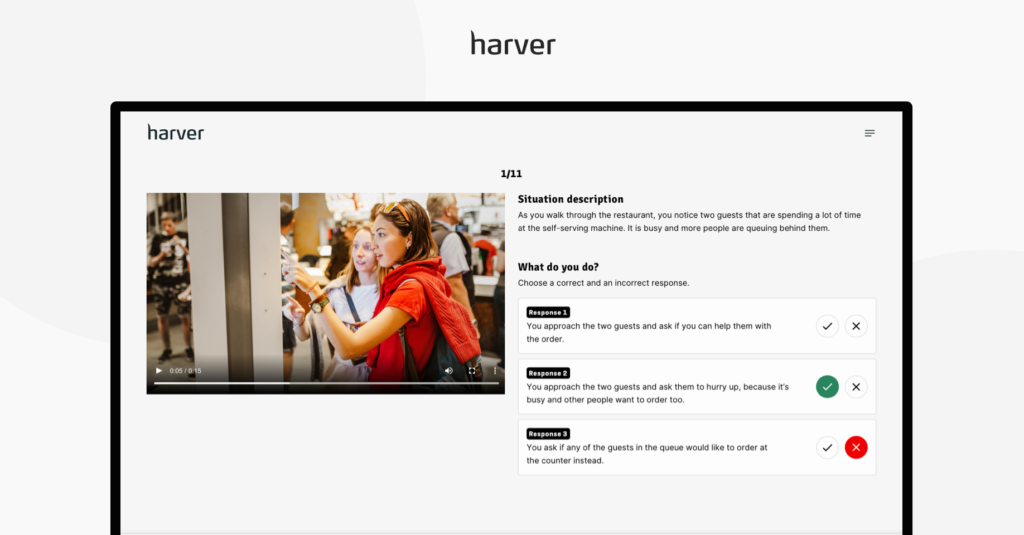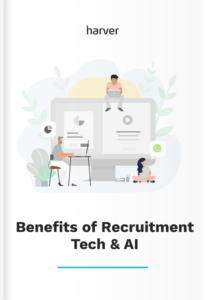The quick-service restaurant (QSR) industry is currently dealing with a tight labor market and an unrelenting war for talent. According to the National Restaurant Association’s State of the Industry 2020 report, three in 10 restaurant operators reported having trouble filling open QSR roles.
There’s a shortage of workers, so the industry operates on a first-come, first-serve model. In other words, most applicants choose the first company that makes an offer, and in many cases – especially in tough markets – multiple companies end up competing for the same talent. Some areas simply have a limited supply of qualified candidates, which makes it difficult to achieve recruitment process efficiency.
Facing such challenges, restaurant owners are getting creative, further incentivizing candidates by increasing wages and offering other perks, such as referral bonuses. Some quick-service restaurants are even offering $50 to candidates who simply show up for a job interview.
Meanwhile, most QSR recruiters are scrambling, on the hunt for ways to outpace competitors, attract and hire the best possible candidates and reduce high turnover rates to avoid staffing shortages. That’s where a fast and efficient process, powered by technology, comes into play. So let’s dive into the topic and see how quick-service restaurants can improve their hiring process efficiency.
What’s in?
- White paper
Before you continue!
Don’t forget to grab your free copy of our white paper on the digital transformation of restaurant volume hiring. Learn about:
- The challenges currently shaping the restaurant recruitment space
- How restaurant employers can navigate the tight labor market, and the role of technology in a future-proof recruitment process
- The four building blocks of a fully digital recruitment process

What are typical recruitment bottlenecks for QSRs?
Before we dive into the solutions, let’s talk first about the biggest and most significant recruitment bottlenecks that impede efficient QSR recruiting. The QSR industry is unique and subject to many frustrating, time-consuming challenges that may not impact recruiters in other industries.
Some of the most common recruitment bottlenecks for QSRs include:
Unmet candidate expectations
Mismanaged candidate expectations are a significant pain point for most QSR recruiters. Low quality or ill-fitting hires with unmet expectations often result in lost time and money for recruiters, in addition to higher attrition rates. Even the very best QSRs lose almost 100% of their employees each year, and in some cases, turnover in the quick-service restaurant industry can even run as high as 130% to 150%.
Uneven supply and demand
It’s not only the labor shortage impacting QSR recruitment. Uneven supply and demand is another headache, specifically for multi-location quick-service restaurants. Due to limited resources, some locations take longer to reply, which leads to candidates choosing roles with competitors. Some locations also receive fewer applications than others on average, making the roles in these markets tougher to fill than normal.
Decentralized recruitment process
Many QSR recruiters use too many recruitment tools, and each location may even have its own unique recruitment strategy and selection criteria. Because of this, recruitment and hiring data is often not collected and analyzed centrally, so there is very little insight into the overall recruitment process. This decentralization makes it hard to make decisions at headquarters, where employees are likely siloed from various locations.
We’ve detailed these challenges and the particularities of volume recruitment in the quick-service restaurant industry in the articles below.
6 solutions for improving the QSR hiring process
Despite the inherent challenges that come with being a QSR recruiter, there are multiple ways to enhance your hiring processes for greater efficiency and effectiveness—all of which are supported by technology.
With access to dedicated recruitment solutions for QSRs, like those we offer at Harver, you can drive significant improvements and beat your competitors to the punch, hiring the best of the best in your area for each and every open role. Here’s how:
1. Improve sourcing with programmatic job advertising
Developing an efficient and effective QSR recruitment process starts with sourcing the right candidates—and not spending too much time or money while doing so. Although major job boards like Indeed and ZipRecruiter can be useful for filling some roles, the best recruiters don’t wait around on these sites to find top candidates.
Typically, popular job boards are chock-full of postings for open roles and standing out to attract candidates can be quite challenging. However, programmatic job advertising—the purchasing, publishing, and optimizing of job ads using automation software as opposed to actual people—is an excellent way to expand the number of potential candidates you can reach with just a few clicks.
When you invest in programmatic job advertising, your ads show up all over the internet rather than just on popular job boards that are inundated with other listings.
All you need to do is find software that offers an automated system for purchasing space to advertise your open roles. Then, you can use the solution to specify “rules”, or details of your target demographic, and your technology does the rest, harnessing the power of A/B or “split” testing and artificial intelligence (AI) to optimize placement.
How AI & recruitment technology is changing recruiting experience
Find out how tech has helped other companies grow by enhancing both the recruiters’ and candidates’ experience!
2. Screen candidates with pre-hire assessments
Another great way to improve QSR process efficiency is to screen candidates before you move them to the interview stage of the recruitment funnel. Screening candidates in advance with pre-hire assessments designed for the QSR industry can help you find the best match for both the open role in question and the organization as a whole.
There are countless pre-hire assessments available, with the option to measure everything from job knowledge, cognitive abilities, and cultural fit assessments, to personality traits, and more. To make the best possible use of pre-hire assessments, you should start by defining your goals: What are you looking for in a new hire? What qualities, characteristics, and skills matter most?
Once you have a solid idea of what you’re assessing, you can choose the pre-hire assessments that will best meet your needs. From there, you’ll have a narrowed down list of candidates who already meet all of the requirements for the job—without wasting time or resources manually sifting through applications.
Note: You can see Harver’s library of pre-employment assessments below. If you need help in choosing the right ones for hiring QSR employees, check out this guide: QSR Assessments Guide – Finding the Right Candidates at Scale.
3. Allow applicants to self-schedule interviews
While manually scheduling interviews may not seem like a time-intensive process, it’s often cited as one of the most tedious parts of the recruiting process. Going back and forth with different candidates to check their availability and get them on the schedule is a whole process in itself, completely separate from the actual interview that takes place.
Interview scheduling automation can help save time and streamline the interview stage, creating a better experience for both candidates and recruiters alike. By automating the interview scheduling process, you can reduce back-and-forth, offer a better candidate experience, streamline your hiring efforts and speed up the entire recruitment cycle.
Candidates who make it past the pre-employee assessment step can simply self-schedule an interview with your recruiting team if their score matches your predetermined criteria for the position. This way, you can completely automate the scheduling portion of your QSR hiring efforts for ultimate ease and efficiency.
You can learn more about automating your recruitment process in the article below.
4. Offer realistic job previews through SJTs
Too often, quick-service restaurants rush to hire ill-fitting candidates with misaligned expectations. Failure to prepare applicants for life on the job can result in high attrition rates, ultimately creating yet another open role for you to fill—not to mention wasting a QSR’s time, money, and resources.
You can avoid this by using video-based situational judgment tests (SJTs) to offer realistic job previews for each candidate you’re considering hiring.
SJTs offer candidates a preview of the job, allowing them to see what the day-to-day work is like and whether they should move forward with or stop the application process. This is accomplished by showing applicants a variety of real-life workplace scenarios or simulations to predict success in the role you’re hiring for. You can see an example below.

Along with helping to manage expectations, give candidates a deeper understanding of what the job entails, and make the interview stage more meaningful, conducting SJTs will help you ensure you’re hiring the right people with the right skills to reduce employee turnover and improve your QSR’s quality of hire (QOH) as a whole.
If you’d like to see our situational judgment tests in practice, you can book a demo below.
If you’d like to see how Haver can transform your hiring process,
book a demo here!
5. Route multi-location QSR candidates
Multi-location quick-service restaurants face even more hiring challenges, dealing with uneven supply and demand in many of the hard-to-fill markets that are either oversaturated with other open positions, lacking in available talent, or both. However, just because a candidate applies for a certain area doesn’t mean you can’t consider them for other nearby locations.
You can address this pain point by routing multi-location QSR candidates who have the right skills, regardless of the location they applied for. In many cases, the candidate will move forward with the new role regardless, empowering your recruitment team to increase your process efficiency. This will help you staff tough markets faster, improving your time to hire and ensuring no role goes for too long without being filled.
We’ve detailed the topic in the webinar below.
6. Collect and analyze recruitment data centrally
As we mentioned before, fragmented hiring processes create significant obstacles for recruiters—especially for those staffing multiple locations. Decentralized recruitment processes and siloed data takes time away from other tasks and creates situations where headquarters have little to no insights into how hiring decisions are being made.
Rather than operating despite a lack of data and visibility into recruitment processes, you should look to collect and analyze your hiring insights in one centralized, easily accessible location. By implementing an end-to-end digital hiring solution for all your QSR’s locations, you can gain newfound visibility, help locations better coordinate their hiring efforts, and speed up the decision-making process by making it more data-driven.
We’ve written about recruitment data and detailed some of the dashboards available in the Harver platform below.
Final thoughts on improving hiring efficiency
With powerful recruitment automation technology for QSRs at your fingertips, you can develop a top-notch recruitment process that works for you—not against you.
Harver’s QSR recruitment software empowers restaurant owners, managers, and recruiters to fill roles efficiently and effectively, putting top candidates in positions that align with their expectations and streamlining your QSR hiring processes—especially when you’re volume hiring for multiple roles at one time.
Ready to transform your hiring process?









